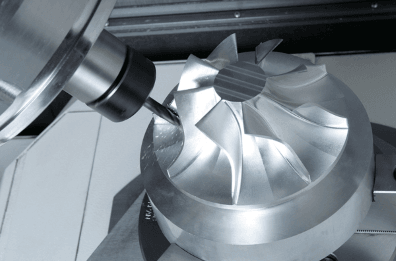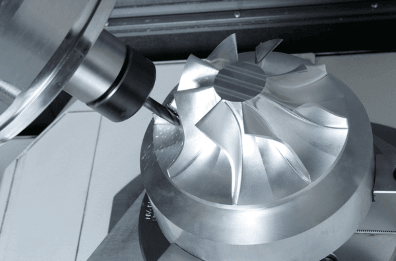With the development of machine technology, products with complex surfaces are needed especially for the aerospace, automotive, defense and mold making, and medical sectors. Computer-aided design tools have been developed to meet this need, making applications such as surface and solid modeling much easier. The design of these products is as important as their production.
In 3-axis milling, the workpiece must be connected several times. 5 axis machining machines have been developed in order to produce a part in one connection. The axes are automatically positioned precisely along the direction in which they move.
The term 5-axis refers to the number of directions in which the cutting tool can move. In a 5-axis machining center, the cutting tool moves on the X, Y, and Z linear axes and the A and B axes rotate to approach the workpiece from any direction. In other words, you can process five sides of a part with a single setting. Because the workpiece is not connected/disconnected between multiple operations, it provides higher part precision and quality.
Today, with the development of technology, shaping the material is done through computer programs. More complex shapes are produced with less material loss with CNC machining.

Need to Know Common Definitions
NC (Numeric Control): Numerical Control (NC); This is the technique of instructing the machine with commands consisting of numbers, letters, punctuation, and other symbols for the control of a process. The machine responds to the coded information in the desired order and manner to perform various machining functions.
They are the systems that can perform the desired movements automatically. It is capable of executing a single block of information assigned to it.
CNC (Computer Numerical Control): is automatic control of machining tools (drills, boring tools, lathes). A CNC machine operates a piece of metal to fulfill specifications by following a coded programmed instruction and while not a manual operator.
CAD (Computer-Aided Design): CAD systems are used as the first step of the design-manufacturing process. Computer-Aided Design is the realization of the 3-D model of the part to be produced in the actual dimensions and the necessary analysis. The creation and analysis of complex surfaces can be done with CAD packages easily.
CAM(Computer-Aided Manufacturing): This is the next stage of the manufacturing process after CAD. CAD model information; It is used in CAM software for turning the raw material into the desired shape by turning, milling.
In CAM, first, a stock model is created by giving measurements for the design model taken from CAD or automatically. The stock model is the semi-finished state of the part before processing. In other words, this is the part that is connected to the CNC machine used in the simulation to reach the target model. The target model is the machined version of the part coming out of the CNC machine.
What Are The Benefits of CNC Machines?
The factors that play a role in the development of CNC machines are listed as follows:
- Reducing the unit cost by increasing the speed of production
- Easy production of parts that are difficult to shape and measure and require many processes
- Deterioration of shape and dimension accuracy of mass production parts and easy control
- Production of parts that cannot be processed by classical methods.
Pros and Cons of CNC Machining?
Advantages
⦁With a 5-axis CNC machine, the machining time is reduced by removing sawdust at high speeds. This increases the quality of the ratio by machining the part at low tolerances.
⦁In a 5-axis machining, expensive and complex fixtures are not required for machining complex surface geometries.
⦁More precise machining is achieved, which has the advantage of connecting the part once.
Disadvantages
⦁The CNC machine costs are higher than others.
⦁It is very important to train the operator or operators who will use the 5 axis CNC machine.
⦁The 5-axis machining is more complex than the 3-axis and therefore the CNC machine movements need to be well understood.
⦁It is aimed to ensure that the operator knows exactly how the data coming from the CAM program is processed and the issues to be considered for the CNC machine.
Examples of CNC Machines
1.Mill: Translates programs consisting of specific numbers and letters to move the workpiece to varied locations and depths. Functions include face milling, shoulder milling, tapping, drilling, and a few even supply turning. Today, CNC mills can have 3 to 6 axes.
2.Lathe: Workpieces are cut while rotating. Usually using indexable tools and drills occur makes fast and precise cuts. It is effective for complex programs designed to make parts that cannot be made in manual lathes. While it usually has two axes (X and Z), newer models have more axes that enable more advanced work to be done.
3.Plasma Cutter: It involves cutting a material using a plasma torch*. Usually used to cut steel and other metals, but can be used in a variety of materials. In this process, the gas (eg compressed air) is blown through a nozzle at high speed; At the same time, an electric arc is formed from this gas to the surface cut from the nozzle, which converts a portion of this gas into plasma. The plasma is hot enough to melt the cut material and moves fast enough to blow molten metal away from the cut.

4.Water Jet Cutter: Also known as a “water jet”, it is a tool capable of slitting metal or other materials at high speed and pressure using a water jet or a mixture of abrasive material such as water and sand. It is often used in the manufacture of machinery and other devices or in the manufacture of parts. Water jet is the preferred method when the materials being cut are sensitive to high temperatures produced by other methods. It has found applications in a wide range of industries from mining to the space industry where it is used in processes such as cutting, shaping, carving, and reaming.
5.Electric Discharge Machining(EDM): also known as Spark processing, spark erosion, combustion, die sinking or wire erosion. EDM is a manufacturing process in which a desired shape is achieved by using electrical discharges (sparks).
In addition to the aforementioned, there are CNC machines with many different features and suitable for the desired process. Particularly with the automation to meet the increasing needs in the space, defense, automobile, and medical sectors, it became possible to produce more complex-shaped parts with less material loss and labor savings.
Computer-aided manufacturing will continue to make our lives easier and help us improve ourselves.
*Plasma Torch: A device for generating a directed plasma flow or plasma gun
You May Be Interested:


